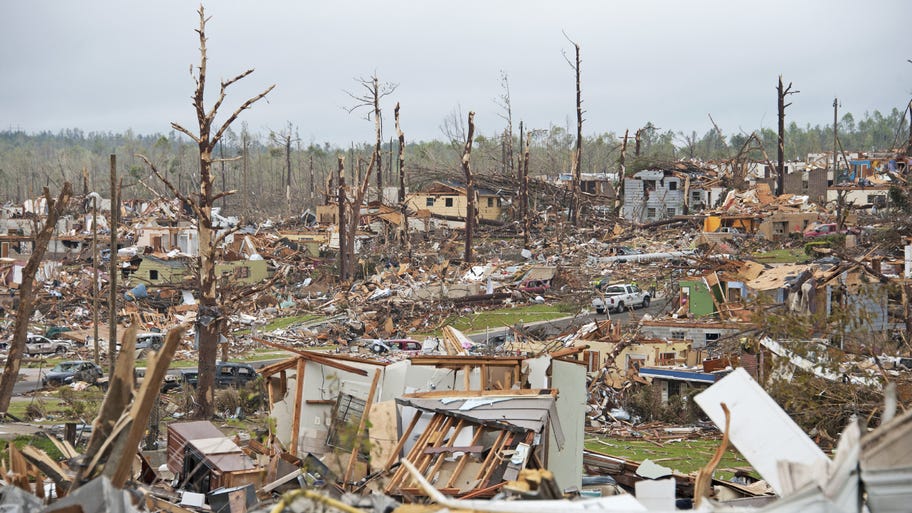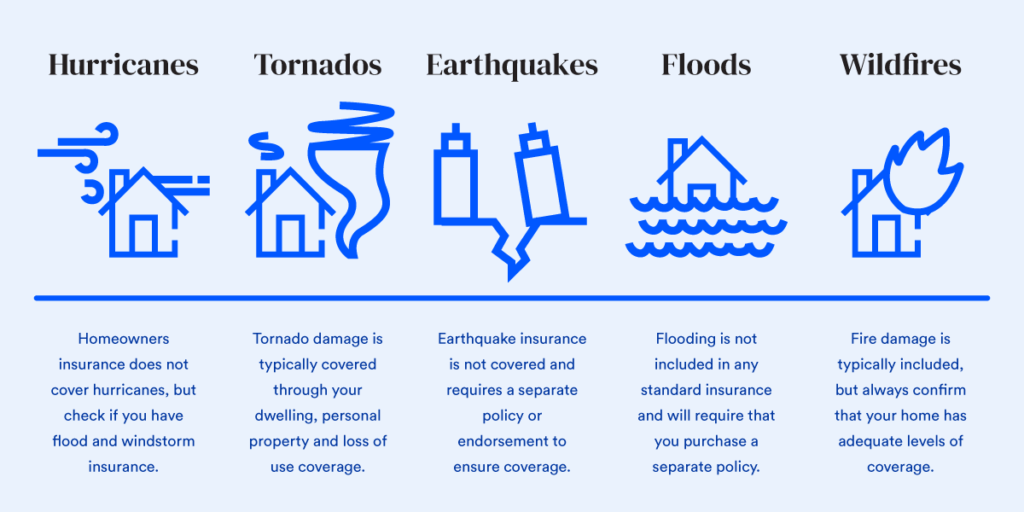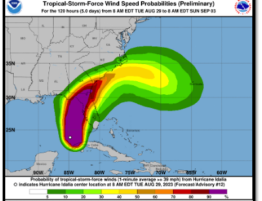
In 2020, Covid-19 killed more than 385,000 Americans, wildfires took hold in California, and seven major hurricanes – a record high – hit the Atlantic coast. While 2021 holds promise, researchers have found that climate change threatens to increase the strength of hurricanes in the coming years. Instead of living in fear, preparation for future emergencies can bring families peace of mind.
Preparation can help keep you and your loved ones safe – especially if any of your family members live with disabilities. The elderly, persons living with disabilities and those with mobility issues may have a difficult time securing property and reaching safety without proper preparation. For your benefit, our detailed disaster preparedness guide rounds up resources, disaster safety tips and assistive technology to help you and your family prepare for an emergency.
Table of Contents
- Preparing for extreme weather
- Creating a plan
- Car safety and evacuation tips
- Home safety and precautions
- Preparedness for people with disabilities
- Preparedness for seniors
Preparing for extreme weather
Disasters often occur with little warning, which can hamper your ability to reach safety. Seniors and those with disabilities might also have mobility issues that can make it more challenging to vacate quickly. Hurricane Katrina was a glaring example of this, with people over the age of 75 comprising half of all storm fatalities.
Seniors and people with disabilities also have greater difficulty maintaining their day-to-day lives without critical resources, such as medication, food, water and a safe place to rest. More vulnerable citizens may experience difficulty reaching resources and may be unable to effectively communicate those needs to others who can help. Other resources like in-home or medical care may be unavailable, or access may be cut off. People who depend on at-home medical resources may be more vulnerable to risk during a disaster, since they often need medical supplies and power. Disaster preparedness pays off in the long run, especially when you are disabled or a senior.
These five natural disasters can all impact your home and life in different ways.
Hurricanes
Hurricanes often create severe winds that can cause widespread, extended power outages. Winds and driving rain can also break windows and damage roofs, causing thousands of dollars in related damage. While there is no homeowners or renters insurance that specifically covers hurricanes, you should consider checking whether your provider offers flood insurance and windstorm insurance if you live in an area where hurricanes are common.
Tornados
A tornado can strike out of nowhere, capturing vehicles and entire homes in its punishing cyclone. Tornado damage is typically covered under a standard homeowners insurance policy through your dwelling, personal property and loss of use coverage.
Earthquakes
California is known for earthquakes, but that is not the only place they can occur. Earthquake insurance is not covered by the standard home insurance policy, instead of requiring a separate policy or endorsement to ensure coverage.
Floods
Flooding can destroy property and even whisk away entire homes, but it is not included in any standard homeowners insurance policies and will require that you purchase a separate policy. Flooding is such an issue in the U.S. the federal government offers its National Flood Insurance Program with a convenient flood zone map that allows you to check your address.
Wildfires
Approximately 4.5 million U.S. homes are at risk of wildfire, highlighting the need to safeguard against fire if you live in these areas. Fire damage is typically included in your home insurance policy. Still, if you live in an area prone to wildfires, it is always a good idea to confirm adequate levels of coverage with your home insurance company.

Creating a plan
If any of these natural disasters take place, having a plan in place beforehand can help your family stay safe.
Establish an emergency support network
Establishing an emergency support network is an important step in preparing for a natural disaster. If you have advance notice of a natural disaster or other emergency, you may want to notify a network of family, friends, neighbors or coworkers and ask them to check on you regularly so they can stay up-to-date on your health and well-being. Prior to the expected disaster, you may want to also send important information to your emergency network, such as your address, the location of your medications and more.
Register for help
Not everyone has an emergency network of family and friends to rely on in times of disaster. An alternate option is to register for help. Several local and federal disaster programs such as FEMA provide emergency support to those in need. You may want to see if these programs could apply to you, and if so, register for help in advance.
Have a plan for pets
You may also want to develop a plan for your pets. If you are evacuating from an emergency situation, you may not be able to take animals with you. You could ask a member of your emergency support network to take in your pet or you could contact your local shelter and see if they can house your animal or help facilitate a foster home.
Create an emergency preparedness kit
Another important piece is to develop an emergency preparedness kit. The contents of your kit will look different depending on your needs. For instance, seniors and persons with disabilities may need to include specialized medical care items like oxygen tanks.
- Medications and prescriptions
- Emergency documents, such as a health information card
- Flashlight and batteries
- Personal identification card
- Credit cards and bank cards
- Sleeping bags
- Bottled water (the CDC recommends 1 gallon per person, per day)
- Non-perishable food items
- A fully-charged cell phone
- Strike-anywhere matches
- Tool kit
- Flashlight
- Household goods such as plastic bags, paper plates and cups
- Masks and disinfectants
Car safety and evacuation tips
When disaster strikes, it can be hard to figure out an evacuation plan, but planning ahead can make things go much more smoothly.
Who to call for evacuation for people with mobility issues
If you decide to evacuate before or after an emergency, it’s important to be prepared. If you live with a disability or have mobility issues, you may qualify for special transportation offered by local or federal programs. The state of Texas allows citizens with special needs to call 211 to request transportation services in an emergency. FEMA recommends those with disabilities contact public transit prior to natural disasters. Many public transit systems have accommodations such as wheelchair lifts that allow those with disabilities to travel with ease.
Evacuation emergency checklist
During an evacuation, things can move very quickly, so it could be helpful to create a checklist to ensure you have everything you need. Many of the items you’ll likely want to stockpile – such as canned goods, bottled water, and important documents – may already be included in your emergency checklist. However, there may be some additional items you should add for an evacuation:
- Medical supplies: Make sure to make a note to grab any life-saving supplies, such as extra oxygen tanks or insulin.
- Care instructions:Since you won’t be in your home, put together a list of instructions on how to administer any medicines or treatments that you take, so that those around you can help you in an emergency.
- List of emergency contacts: Include a list of your most important emergency contacts (and be sure to include several people in case someone can’t be reached). A list of your contacts could become important if something happens to you during the evacuation before you are reunited with friends and family.
- Important documents or photos: Keep in mind that you may be limited in how much stuff you can bring with you during an evacuation, but you may want to pick out your most prized possessions or photos, and any important documents, such as your birth certificate or will, in case your home is damaged or destroyed. If you have enough advance notice, consider shipping some of those items to trusted family or friends to ensure it is kept safe.
- Entertainment: If you are evacuated to a shelter, you may spend long hours by yourself until the emergency passes. Again, space is a consideration, but you may want to put aside your e-reader, iPad or a deck of cards in a handy place so you have something to entertain yourself in case of evacuation.
Home safety and precautions
During a disaster, some folks may decide to stay at home or shelter in place rather than evacuating. Sheltering in place can be difficult for people with disabilities or seniors. If you live with a disability or mobility issues, you can still shelter in place, but you may want to place special attention on building up your support network, home modifications and assistive equipment well before any disaster happens.
For instance, make sure medical items you need such as oxygen tanks or insulin are stockpiled and easily accessible. You may also want to notify your support network that you will be sheltering in place so that they can check on you before, during and after the emergency. And make sure you have plenty of food and water, along with a flashlight and batteries, so you can meet your basic needs during the emergency.
Preparedness for people with disabilities
When you live with a disability, some simple planning ahead can make all the difference. These safety tips can help you prepare if there is ever an emergency or disaster in your area.
Car safety
If you need to evacuate, there are some extra tools that can help drivers with disabilities stay safe behind the wheel.
- Siren alert device: Compatible with both your home and vehicle, a siren alert is an easy way to call for help in an emergency, especially for those drivers with hearing loss.
- Driving glasses: Driving requires you to see in detail, something that isn’t easy for everyone. A pair of glasses can ensure clear vision and also serve as an anti-reflective tool when driving at night.
- Assist bars or straps: A sturdy assist bar or strap can help you pull yourself in and out of the vehicle.
- Swivel cushion: A swivel cushion can help you move from a wheelchair to the driver’s seat with far less trouble by turning with you to ensure easier movement.
- Turny or valet seat: A turny, or valet seat, is another way to transfer from a wheelchair to your car by using a seat that exits the vehicle and lowers itself down to the appropriate height of your wheelchair.
- Car ramps: A car ramp allows you to simply wheel your chair into the vehicle without any need to leave your wheelchair at all.
- Reclining seats: Reclining seats ensure comfort and make it easier for you to move in and out of the car.
- Hands-free navigation: Eliminate one worry by utilizing hands-free navigation that can keep you on track with minimal disruption.
- Lane-keeping assist: Lane-keeping assist is a newer technology that will sound an alert if you stray from your lane.
- Pedestrian detection: Pedestrians can dart into traffic without warning, but pedestrian detection can slow or stop your vehicle immediately in response.
- Forward collision warning: If a car suddenly stops or cuts in front of you, a forward collision warning helps prevent a collision by hitting the brakes.
Home safety
As important as it is to secure yourself outside of the home, you also must secure yourself within your house, and these tips can help.
- Register for emergency assistance: The federal Disaster Assistance program can help you find an emergency management agency in your state, as well as medical and other disaster relief in your area.
- Have a plan: Work with the other members of your household to create a plan of action if there is an emergency. Your plan should include everything from evacuation routes and local shelters to communication and preparation for your pets and service animals.
- Know your support network: Identify what resources are available to help in a crisis, and connect with neighbors, caregivers and out-of-town family members to collaborate on emergency preparedness and evacuation.
- Have seats in the showers: A seat in the shower can help prevent slips and falls, especially if you are in a hurry. Invest in a mobile version that can be taken with you if you need to leave home.
- Grab bars and safety rails: Like a shower seat, grab bars and safety railings can help provide stability and balance when moving around the house.
- Wider hallways: Investing in wider hallways can simplify and improve mobility by providing room for wheelchairs and making it easier to move with bags and belongings.
- Pillow and bed alarms: These special alarms are designed to wake even the deepest sleeper with optional sound, vibrating and shaking effects.
- Light alarms: These alarms can also ensure that you wake by using bright lights to signal that it is time to wake up.
- Alexa and Google Home: These smart home systems use technology to simplify your life, doing everything from turning off the lights to locking doors with just the touch of a button.
- Set appliance reminders: Many appliances have easy reminders that you can set and use to turn your appliances on and off even if you are away from home.
- Reduce the risk of falls: Keeping your home tidy and free of clutter can help reduce the risk of trips and falls.
Preparedness for seniors
As we age, our needs begin to change, impacting our ability to evacuate in a hurry safely. If an emergency strikes, seniors may benefit from taking the following steps for quick evacuation.
Car safety
Every day, we spend a lot of time in our cars, but our vehicles can be an invaluable lifeline if we need to leave quickly. Preparing your vehicle with the right accessories and products can ensure senior driver safety, even in an emergency.
- Blind spot monitors: Eyesight can weaken with age, but blind-spot monitors will sound an alarm if you attempt to merge when there is a vehicle in your blind spot.
- Rear view monitors: These monitors can work either as a backup camera or a continuous monitoring system that can help you see around the back of your vehicle.
- Car lighting: Interior and exterior lighting in your vehicle can help ensure visibility at all times of the day and night, no matter where you are.
- Adaptive headlights: These headlights are extra convenient because they automatically adjust based on changing conditions on the road.
- Automatic high beams: Turning your high beams on and off can add stress in traffic, so automatic high beams alleviate that burden by automatically adjusting themselves based on the surrounding lighting.
- Auto-dimming side-view mirrors: As headlights become even brighter and sharper, they can wreak havoc on your eyes while driving, but auto-dimming side-view mirrors ensure that the reflection of other cars’ headlights doesn’t interfere with your vision while driving.
- 360-degree camera systems: Instead of just one camera, you can benefit from several that are strategically placed around your vehicle.
- Driver drowsiness detection: This new technology uses facial recognition and machine learning to recognize and prevent drowsy driving.
- Automated emergency braking: All it takes is just one second with your eyes off the road, and an accident can happen, but automated emergency braking will activate the brakes if you fail to first.
- Steering knobs: Also known as a Brodie knob, knuckle buster and wheel or suicide spinner, these steering wheel knobs allow for one-handed steering and easier navigation along curves and turns.
- Automated crash detection: This app can be used on your smartphone or some vehicles to detect a collision and summon help automatically.
- First responder access: Services like Onstar allow first responders to summon help and communicate with you directly, receiving potentially life-saving information that can help emergency services when they arrive.
- Hands-free phone use: Cell phone use is one of the primary causes of distracted driving, but utilizing hands-free phone technologies, whether through your car or via smartphone, can ensure you operate your vehicle safely while enjoying your conversation.
- Keyless vehicles: Fumbling with keys is an extra headache that can also waste precious seconds in an emergency, but keyless cars can help you get on the road that much faster.
- Extra wheelchair or walker: If you have to evacuate in an emergency, you may not have time to load your wheelchair or walker, so having an extra set in the car can ensure you still have your mobility even if you need to leave quickly.
Home safety
Seniors can benefit from some minor home modifications and renovations that can make a significant difference in mobility and safety at home.
- Replace stairs with ramps: Stairs may take more effort or bring more risk than necessary, so installing ramps can ensure safer passage between floors.
- Install hand railings: Regardless of whether you have stairs or ramps, hand railings can give you better balance, so you don’t fall or trip.
- Use life alerts: In an emergency, you can use a wearable life alert to summon emergency medical help without having to reach for a phone.
- Enroll in prescription deliveries: Have your medical prescriptions delivered to you by enrolling in a provider-based or community program that will bring your medicine to your doorstep.
- Centralize communication: Using a central communication hub, such as an Alexa or Google Home smart home system, can make it easier to communicate with other people or even other devices in your home for simpler living.
- Use easy-to-navigate computers: The Internet is an incredible resource in an emergency, but some operating systems can be intimidating, so choose a computer and operating system that is easy for you to navigate.
- Register for disaster assistance: Several local and federal disaster programs can provide emergency disaster support, so take the time to explore what programs may be available to you and register in advance.
- Set daily and weekly reminders: Several mobile and smart home devices allow for daily and weekly reminders that can help you track prescription reminders and other essential tasks.
- Use an electric stove:Gas stoves can present a significant fire risk in your home, but replacing your stove with an electric model can not only reduce risk but lower your utilities each month, too.
- Add extra oxygen tanks: In an emergency, it may be different to get to critical, life-saving supplies, so plan ahead by keeping a few extra oxygen tanks stashed safely within your home.
Every second counts in an emergency, but the challenges are greater for seniors and people with disabilities who experience trouble with mobility. When there is not a second to spare, emergency disaster preparedness can help.
Today’s developments in smart technologies, combined with adequate homeowners or renters insurance, can make an enormous difference not only to your daily living but also when you need to evacuate quickly in an emergency. Simple modifications to your home and vehicle can mean the difference between safety and distress when disaster strikes.












Write a comment:
You must be logged in to post a comment.